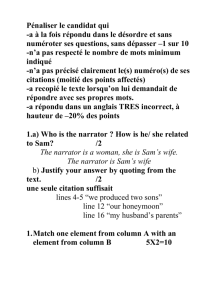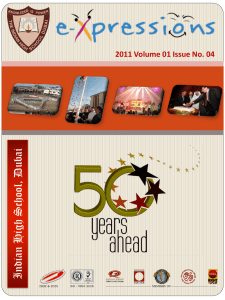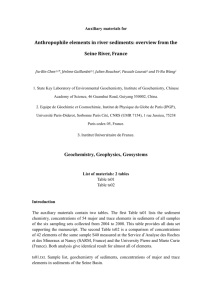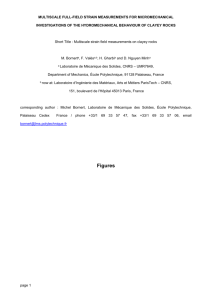Estimate , the mean number of unoccupied seats per
advertisement
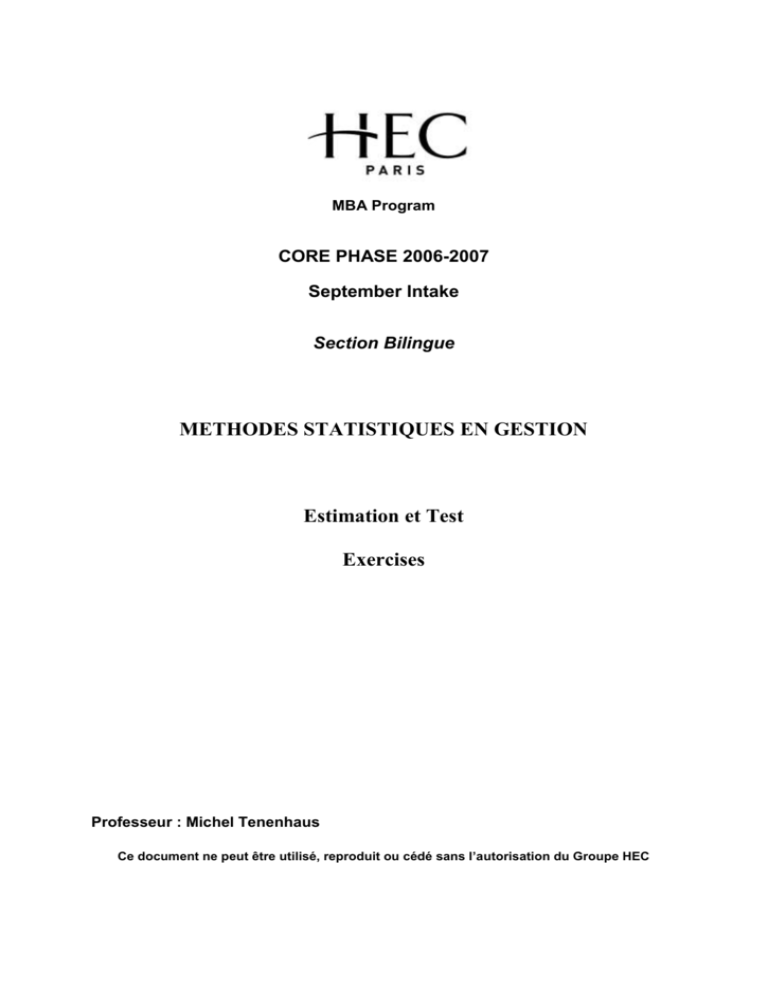
MBA Program CORE PHASE 2006-2007 September Intake Section Bilingue METHODES STATISTIQUES EN GESTION Estimation et Test Exercises Professeur : Michel Tenenhaus Ce document ne peut être utilisé, reproduit ou cédé sans l’autorisation du Groupe HEC EXERCICES ESTIMATION ET TEST Les textes en anglais sont extraits de : J.T. McClave, P.G. Benson & T. Sincich, Statistics for Business and Economics, Seventh Edition, Prentice Hall International, 1998. Les textes en français ont été proposés par les professeurs du département SIAD. I. ESTIMATION D’UNE PROPORTION ET D’UNE MOYENNE 1. Many public polling agencies conduct surveys to determine the current consumer sentiment concerning the state of the economy. For example, the Bureau of Economic and Business Research (BEBR) at the University of Florida conducts quarterly surveys to gauge consumer sentiment in the Sunshine State. Suppose that BEBR randomly samples 484 consumers and find that 257 are optimistic about the state of the economy. a. Use a 95% confidence interval to estimate the proportion of all consumers in Florida who are optimistic about the state of the economy. Based on the confidence interval, can BEBR infer that the majority of Florida consumers are optimistic about the economy? b. Repeat part a, using a 90% confidence interval. 2. According to the Minneapolis Star (May 2, 1980, p. 11A), the federal government requires states to certify that they are enforcing the 55-miles-per-hour speed limit and that motorists are driving at that speed. A state is in jeopardy of losing millions of dollars in federal road funds if more than 60% of its vehicles on 55-mph highways are exceeding the speed limit. The Minnesota Highway Patrol conducts 70 radar surveys each year at a total of 50 sites to estimate the proportion p of vehicles exceeding 55 miles per hour. Each sample survey involves at least 400 vehicles. a. How large a sample should be selected at site # 42 on Interstate 35W to estimate p to within 3% with 95% confidence? Last year approximately 60% of all vehicles exceeded 55 miles per hour. b. The highway patrol also estimates to within 0.25 mile per hour with 90% confidence. Assume that the standard deviation of vehicle speeds is approximately 2 miles per hour. How large a sample should be taken at site # 42 to estimate with the desired reliability? 3. Unoccupied seats on flights cause the airlines to lose revenue. Suppose a large airline wants to estimate its average number of unoccupied seats per flight over the past year. To accomplish this, the records of 225 flights are randomly selected and the number of unoccupied seats is noted for each of the sampled flights. The sample mean and standard deviation are x 11.6 seats s = 4.1 seats Estimate , the mean number of unoccupied seats per flight during the past year, using a 90% confidence interval. 1 4. The United States Golf Association (USGA) tests all new brands of golf balls to assure that they meet USGA specifications. One test conducted is intended to measure the average distance traveled when the ball is hit by a machine called “Iron Byron,” a name inspired by the swing of the famous golfer Byron Nelson. Suppose the USGA wants to estimate the mean distance for a new brand with a 90% confidence interval of width 2 yards. Assume that past tests have indicated that the standard deviation of the distances “Iron Byron” hits golf balls is approximately 10 yards. How many golf balls should be hit by “Iron Byron” to achieve the desired accuracy in estimating the mean. 5. La société Unilever possède une division Produits de Soins, dont fait partie le savon DOVE. Pour estimer le marché potentiel d’un nouveau produit, un sondage est effectué pour mesurer la consommation moyenne de savon dans la population considérée comme la cible privilégiée de ce produit (femmes actives de plus de trente cinq ans et de moins de soixante ans). La consommation mensuelle moyenne ressort à 3,73 onces (l’unité de mesure internationale utilisée chez Unilever) sur un échantillon de trente personnes, avec un écart-type calculé de 1,6 once. a) b) Donner un intervalle de confiance à 95% de la consommation mensuelle moyenne de savon de la population cible. Calculer la taille de l’échantillon permettant de réduire la largeur totale de l’intervalle de confiance à 95% à 0.5 onces ? II. TESTS DE COMPARAISON A UN STANDARD 6. Florida’s housing market remains strong due to the steady stream of new residents fleeing harsh northern winters. This year, the state association of realtors claims that the mean cost of a new home in Florida is $90 380. One realtor who claims that this figure is too low obtained a random sample of 30 sale prices from a list of all homes sold in Florida during the last 6 months. The sample mean and standard deviation were: x $93 290 a. b. 7. s = $6 500 The realtor wishes to conduct a hypothesis test to substantiate her claim. Identify the null and alternative hypotheses of interest to her. Find the observed significance level for this test, and interpret its value. The beta coefficients of stocks are a measure of their volatility (or risk) relative to the market as a whole. Stocks with beta coefficients greater than 1 generally bear greater risk (more volatility) than the market, whereas stocks with beta coefficients less than 1 are less risky (less volatile) than the overall market (Sharpe and Alexander, 1990). A random sample of 15 high-technology stocks was selected at the end of 1990, and the mean and standard deviation of the beta coefficients were calculated: x 1.23 a. b. s = 0.37 Set up the appropriate null and alternative hypotheses to test that average hightechnology stock is riskier than the market as a whole. Establish the appropriate test statistic and rejection region for the test. Use = 0.10. 2 c. d. e. What assumptions are necessary to assure the validity of the test? Calculate the test statistic and state your conclusion. What is the approximate p-value (or significance level) associated with this test? Interpret it. 8. In any bottling process, a manufacturer will lose money if the bottles contain either more or less than is claimed on the label. Accordingly, bottlers pay close attention to the amount of their product being dispensed by bottle-filling machines. Suppose a quality manager for a catsup company is interested in testing whether the mean number of ounces of catsup per family-size bottle differs from the labeled amount of 20 ounces. The manager samples nine bottles, measures the weight of their contents, and finds that x 19.7 ounces and s = 0.3 ounce. a. Does the sample evidence indicate that the catsup dispensing machine needs adjustment? Test at = 0.05. b. What is the p-value for the hypothesis test you conducted in part a? c. What assumptions are necessary so that the procedure used in part a is valid? d. Find a 90% confidence interval for the mean number of ounces of catsup being dispensed 9. A cigarette manufacturer advertises that its new low-tar cigarette “contains on average no more than 4 milligrams of tar”. You have been asked to test the claim using the following sample information: n = 25, x 4.16 milligrams, s = 0.30 milligrams. Does the sample information disagree with the manufacturer’s claim? Test using = 0.05. List any assumptions you make. 10. A major car manufacturer wants to test a new engine to determine whether it meets new air pollution standards. The mean emission, , of all engines of this type must be less than 20 parts per million of carbon. Ten engines are manufactured for testing purposes, and the mean and standard deviation of the emissions for this sample of engines are determined to be x 17.1 parts per million s = 3.0 parts per million Do the data supply sufficient evidence to allow the manufacturer to conclude that this type of engines meets the pollution standard? Assume that the manufacturer is willing to risk a Type 1 error with probability equal to = 0.01. 11. A random sample of 50 consumers taste-tested a new snack food. Their responses were coded (0 = do not like, 1 = like, 2 = indifferent) and listed as follows : a. b. 1 0 0 1 2 0 1 1 0 0 0 1 0 2 0 2 2 0 0 1 1 0 0 0 0 1 0 2 0 0 0 1 0 0 1 0 0 1 0 1 0 2 0 0 1 1 0 0 0 1 Test H0: = 0.5 against H1: > 0.5, where is the proportion of customers who do not like the snack food. Use = 0.10. Report the observed significance level of your test. 3 12. Un producteur de jus d’orange affirme que 52% des consommateurs réguliers de jus d’orange préfèrent son produit. Pour tester cette affirmation, un concurrent recueille un échantillon représentatif de 200 consommateurs réguliers de jus d’orange et constate qu’il n’y en a que 95 qui déclarent préférer la marque du producteur. a) b) 13. Tester l’affirmation du producteur au risque = 0.05. Calculer le niveau de signification du test. Selon le responsable de la communication de General Mills, les bons de réduction de la société ont pour objectif de conduire les consommateurs à acheter ses produits et ses bons de remboursement (offre de remboursement en argent en échange de preuve d’achats répétés) ont pour objectif d’encourager les consommateurs à poursuivre leur achat de ses produits. Dans une enquête nationale organisée par Nielsen en 1990, 57% des personnes interrogées ont indiqué qu’elles utilisaient des bons de réduction pour leurs achat d’épicerie. Dans une enquête de 1998, la société Nielsen a constaté que 66% des personnes sondées déclaraient utiliser ces bons de réduction. Supposons que l’enquête de 1998 ait été conduite sur un échantillon aléatoire de 100 consommateurs, parmi lesquels 66 indiquaient utiliser des bons de réduction. a) Peut-on considérer que l’échantillon de 1998 fournit des preuves suffisantes que le pourcentage de consommateurs utilisant des bons de réduction est supérieur à 57% ? Utiliser un risque = 0.01. b) Calculer le niveau de signification du test. 14. Depuis six mois, le grand hebdomadaire DL-Hebdo est vendu sous sa nouvelle formule. La direction marketing désire évaluer l’impact de ce changement sur la catégorie cadre de son lectorat. Pour cela, une enquête auprès de 500 cadres a montré que 75 d’entre eux sont des lecteurs réguliers de l’hebdomadaire. Question : Sachant que la proportion de cadres lisant DL-Hebdo ancienne formule était de 12%, peut-on affirmer que la pénétration de l’hebdomadaire dans le segment cadre a augmenté ? (Prendre un risque = 0.05). 15. La société SOGEC Une société est spécialisée dans le crédit à la consommation. En 1993, le montant des crédits accordés à ses 60 000 clients était de 24 120 000 F. La société souhaite déterminer la provision pour créances douteuses. A. B. Le chef comptable fait deux hypothèses : La proportion des créances douteuses dans la population des 60 000 créances vaut 0.05. La valeur moyenne des créances douteuses dans cette population est égale à la valeur moyenne de toutes les créances. Calculer la provision pour créances douteuses sous ces deux hypothèses. Un sondage est organisé afin de valider les hypothèses du chef comptable. On tire au hasard 50 créances parmi les 60 000 et on observe 8 créances douteuses dans l'échantillon. 4 1) Estimer la proportion des créances douteuses, à partir des données de cet échantillon. 2) Calculer un intervalle de confiance de au niveau 0.95. 3) La précision de ce sondage apparaissant comme insuffisante, on décide d'augmenter la taille de l'échantillon. Calculer la taille minimum n de l'échantillon permettant d'obtenir un intervalle de confiance de au niveau 0.95 ayant une largeur au plus égale à 0.08. Utiliser dans la formule permettant d'obtenir le résultat la proportion de créances douteuses estimée dans ce premier sondage et le fractile exact de la loi normale réduite. C. On tire au hasard dans la population des 60 000 créances m nouvelles créances de telle sorte que 50 + m = n, valeur trouvée à la question B 3). On observe 43 créances douteuses parmi ces n créances. Ces 43 créances douteuses, ont une moyenne de 408 F et un écart-type de 93 F. En utilisant les résultats sur l'échantillon de n créances, répondre aux questions suivantes. 1) Tester l'hypothèse du chef comptable concernant la proportion de créances douteuses dans la population des 60 000 créances, au risque = 0.05. 2) Construire un intervalle de confiance de au niveau 0.95. 3) Tester l'hypothèse du chef comptable concernant la valeur moyenne de l’ensemble de toutes les créances douteuses au niveau de la population, au risque = 0.05. 4) En utilisant l'estimation de et la conclusion de la question (C.3), estimer la valeur totale des créances douteuses. 5) En utilisant l'intervalle de confiance de de la question (C.2) et la conclusion de la question (C.3), construire un intervalle de confiance à 95% de la valeur totale des créances douteuses. Préciser les applications pratiques de ce résultat au niveau de la provision pour créances douteuses. 16. A pupillometer is a device used to observe changes in an individual’s pupil dilatations as he or she is exposed to different visual stimuli. Since there is a direct correlation between the amount an individual’s pupil dilates and his or her interest in the stimuli, marketing organizations sometimes use pupillometers to help them evaluate consumer interest in new products alternative package designs and other factors. The Design and Market Research Laboratories of the Container Corporation of America used a pupillometer to evaluate consumer reaction to different silverware patterns for one of its clients (McGuire, 1973). Suppose 15 consumers were chosen at random, and each was shown two different silverware patterns. The pupillometer readings for each consumer are shown in the table (in millimeters). Consumer Pattern 1 1 1.00 2 0.97 3 1.45 4 1.21 5 0.77 6 1.32 7 1.81 8 0.91 a. Pattern 2 Consumer Pattern 1 0.80 9 0.98 0.66 10 1.46 1.22 11 1.85 1.00 12 0.33 0.81 13 1.77 1.11 14 0.85 1.30 15 0.15 0.32 Pattern 2 0.91 1.10 1.60 0.21 1.50 0.65 0.05 Use a 90% confidence interval to estimate the difference in the mean amount of pupil dilatation per consumer for silverware patterns 1 and 2. 5 b. c. d. Give a practical interpretation of the interval. Does the confidence interval in part a support the inference that the mean dilatation for pattern 1 exceed that for pattern 2 by more than 0.1 millimeter? Conduct a test of hypothesis to determine whether the data indicate that the mean dilatation for pattern 1 exceeds that for pattern 2 by more than 0.1 millimeter. Use = 0.05. III. ANALYSE DE LA VARIANCE A UN FACTEUR 17. Suppose the USGA wants to compare the mean distances associated with four different brands of golf balls when struck with a driver. A completely randomized design is employed, with Iron Byron, the UGSA’s robotic golfer, using a driver to hit a random sample of 10 balls of each brand in a random sequence. The distance is recorded for each hit, and the results are shown in the table, organized by brand. Sample means Sample standard deviation a. b. c. d. Brand A 251.2 245.1 248.0 251.1 260.5 250.0 253.9 244.6 254.6 248.8 250.8 4.74 Brand B 263.2 262.9 265.0 254.5 264.3 257.0 262.8 264.4 260.6 255.9 261.1 3.87 Brand C 269.7 263.2 277.5 267.4 270.5 265.5 270.7 272.9 275.6 266.5 270.0 4.50 Brand D 251.6 248.6 249.4 242.0 246.5 251.3 261.8 249.0 247.1 245.9 249.3 5.20 Plot the data : Multiple Box-Plot and multiple 95% confidence intervals for the mean distances. Set up the test to compare the mean distances for the four brands. Use = 0.10. Use Scheffé multiple comparisons procedure to compare all pairs of means, with = 0.05 as the overall level of significance. Using a 95% confidence interval, estimate the mean distance traveled for balls manufactured by the brand with the highest rank. 6 SPSS OUTPUT De scri ptives A N Mean St d. Deviat ion St d. E rror 95% Confidence Int erval for Mean 10 250.7800 Lower Bound Upper Bound Minimum Maximum DISTA NCE MA RQUE B C 10 10 261.0600 269.9500 D 10 249.3200 Total 40 257.7775 4.7352 3.8661 4.5009 5.2032 9.5497 1.4974 1.2226 1.4233 1.6454 1.5099 247.3927 258.2943 266.7302 245.5979 254.7234 254.1673 263.8257 273.1698 253.0421 260.8316 244.60 260.50 254.50 265.00 263.20 277.50 242.00 261.80 242.00 277.50 Graphique de dispersion de la distance par marque 280 270 37 260 250 DISTANCE 240 230 N= 10 10 10 10 A B C D MARQUE 7 Intervalles de confiance à 95% des distances moyennes par marque 280 270 260 95% CI DISTANCE 250 240 N= 10 10 10 10 A B C D MARQUE ANOVA Sum of Squares DISTANCE Between Groups W ithin Groups Total Mean Square df 2794.389 3 931.463 762.301 36 21.175 3556.690 39 F 43.989 Sig. .000 DI STANCE a Sc heffe MARQUE D A B C Sig. N 10 10 10 10 Subset for alpha = .05 1 2 3 249.3200 250.7800 261.0600 269.9500 .917 1.000 1.000 Means for groups in homogeneous subs ets are displayed. a. Us es Harmonic Mean Sample Size = 10.000 8 18. An accounting firm that specializes in auditing the financial records of large corporations is interested in evaluating the appropriateness of the fees it charges for its services. As part of its evaluation, it wants to compare the costs it incurs in auditing corporations of different sizes. The accounting firm decided to measure the size of its client corporations in terms of their yearly sales. Accordingly, its population of client corporations was divided into three subpopulations: A: Those with sales over $250 million B: Those with sales between $100 million and $250 million C: Those with sales under $100 million The firm chose random samples of 10 corporations from each of the subpopulations and determined the costs (in thousands of dollars), given in the next table, from its records. a. Construct a multiple Box-and-Whiskers plot for the sample data and plot the 90% confidence intervals for the three subpopulation means. b. Conduct a test to determine whether the three classes of firms have different mean costs incurred in audits. Use = 0.05. c. What is the observed significance level for the test in part b? Interpret it. d. What assumptions must be met in order to ensure the validity of the inferences you made in parts b and c? e. Use Scheffé multiple comparisons procedure to compare all pairs of means, with = 0.10 as the overall level of significance. Sample means Sample standard deviation A 250 150 275 100 475 600 150 800 325 230 335.5 224.0 B 100 150 75 200 55 80 110 160 132 233 129.5 57.0 C 80 125 20 186 52 92 88 141 76 200 106.0 57.0 9 Avalon Cosmetics, Inc. Extrait de L.H. Peters & J.B. Gray, Business Cases in Statistical Decision Making Prentice Hall, 1994 « Ladies and gentleman, I think we’ve got a problem that requires some clear thinking and sound decisions, if we’re going to be in business two years from now. » That’s how Carol Sanderson began the emergency meeting she called on her planning committee. Ms. Sanderson is the founder and CEO of Avalon Cosmetics, a regional, full-line cosmetics company headquartered in Chicago. Avalon Cosmetics was founded almost two decades ago as a copy-cat version of Avon and Mary Kay, two highly successful door-to-door cosmetics companies. Sales associates, called « beauty consultants », knock on doors in their territories and offer housewives free make-overs in hopes of selling cosmetics and grooming supplies. The Avalon « work force » is made up of women who act as independent contractors to the company. They typically are married and have one or more school-age children. If they are aggressive, they can make a good living with Avalon. As importantly, because they have control over their work schedules, they can fit their work in with their family and social obligations. Avalon has a very high profit margin, in part because it has a relatively low overhead burden. Beauty consultants must buy their sample kits and inventory, process and deliver all merchandise, and service customer complaints all in exchange for a percentage of their sales. Thus, Avalon pays relatively few fixed costs. Avalon does, however, have a high opportunity cost if a territory does not produce expected revenues. Nancy Mackay, Avalon’s Director of Marketing, has clarified repeatedly that women will spend money on cosmetics. As she often notes, « If the customers don’t spend money on our product, they will spend it on a competitor’s product! » It is this clear understanding of the cosmetics market that has Carol Sanderson so concerned. She has seen her company’s revenues fall nearly five percent in each of the past two years, and so far, this year looks worse than last! Carol has assembled the planning committee, comprised of the directors of Marketing, Product Development and Human Resources, to focus on this problem and help turn the business around. She has asked them to share their views of the problem and make suggestions for what needs to be done next. Bill Lamb, Director of Product Development, said he’s confused about what to do. He surveyed a sample of customers about their satisfaction with their purchases and said he saw no evidence of a problem. As Bill put it, « We’re doing our job our customers love our products. They say they are repeat customers. They say our prices are right. They say they recommend our product to their friends. They love the personal attention they get from our beauty consultants. I just don’t understand why we are getting deeper and deeper in trouble with such a positive and loyal customer base! » Nancy Mackay agreed. « We’ve asked a number of consumer panels about what new products they’d like to see and what modifications are needed in our existing product line. The feedback I get is consistent we’re making what they want to buy. Perhaps we should reconsider our pricing structure, or come up with discounts, or maybe a game a gimmick to recapture attention in the market place. We might even need to consider advertising. I know all these suggestions cost money, real money, but if our product line is complete and our products are good, then it seems to me that the only thing to do is to stir up some interest in our products. » 10 Carol Sanderson liked the idea of an ad campaign, although she dreaded the thought of the costs that would be involved. To reach their target customers base, housewives, they would probably have to advertise on day-time television, during game programs and soap operas. The costs of advertising at that time and for those TV programs, however, might be prohibitive. Carol continued the discussion by asking, « How else can we reach our customers? We know a lot about our customer base they’re women between the ages of 27 and 44, they stay at home to raise their kids, and they love the attention provided by our beauty consultants. » Cathy Eller, Director of Human Resources, followed up on Carol Sanderson’s last comment. Cathy began her comments by asking about how long ago the customer profile was developed. She then said, « The reason I ask is, well, I’ve been reading a lot lately about the changing demographics of the working world. One magazine article I read pointed out that more and more women are entering the work force. Let’s assume this is true maybe our problem is not the product line, or our pricing, or our advertising. Maybe, our sales are going down because our ‘customer’ is no longer at home to answer the door when our beauty consultants knock on it! Maybe, just maybe, our customers are among the women who are finding their way into the work force. » This was clearly a very provocative statement. Nobody had considered this possibility. If Cathy’s idea were valid, then it would require some serious thought about what to do. After all, Avalon Cosmetics became successful in part because they were good at developing excellent product at attractive prices and serving their customers with a personal touch. If the problem were not one of product, pricing, or sales approach, they would have to « create » a novel solution that went beyond the assembled expertise of the planning committee. Carol Sanderson asked, « How do we find out if you’re right about this, Cathy? » Do we have access to any information that would be useful? » Cathy Eller thought for a moment and, with a big smile on a face, announced, « I think we can do it from the information our beauty consultants keep on each of their clients. If you’ll remember, beauty consultants are asked to keep information about each client who makes a purchase. They are supposed to record the type of product purchased and the total purchase price of each transaction. We even asked them to record the number of time they called on each customer at home before making a sale and the time of day this customer contact was made. More importantly, we asked them three years ago to get more information about each customer. We asked them for their clients’ ages and the number of children each has. I think we even asked them to include information about whether the client had a job outside the home! » « Great, » said Carol Sanderson. « When can we get a summary of that information? » Cathy responded, « I’ll have my staff pull those numbers together and summarize them by our next meeting. I’ll even ask them to speculate on what these results might mean for our business. I’ve got some really bright people working for me who are good at figuring out what needs to be done to solve problems. Who knows, maybe we can turn our problem into an opportunity. » Carol Sanderson agreed that Cathy’s staff should “pull together” the numbers, analyze them and interpret the results, and make suggestions about their meaning for the company. She ended the meeting by expressing her hope that Cathy’s efforts would lead to somewhere productive. 11 Cathy Eller went to her customer data base and drew three random samples of 100 customers each who purchased Avalon products during the summers of 1990, 1991 and 1992. She had her staff contact the beauty consultants to obtain relevant information on each of their customers. For each customer, information was collected on: (1) the date of purchase, (2) the amount of purchase, (3) the number of times the beauty consultant visited a customer’s home before making contact with the customer, (4) the time of day that the initial contact was made, (5) the client’s age, (6) the number of minor children at home, and (7) whether or not the customer was employed outside the home. These data were coded, and a computer file was created in preparation for data analysis. Assignment As a member of Cathy Eller’s staff, you have been assigned the task of analyzing and interpreting the data that Cathy Eller created. You’ll find these data in the AVALON.SAV file (disponible à partir du site Web Siad.hec.fr, rubrique Statistique, cours Statistique). A description of this data set is given in the Data Description section. Your analyses should be aimed at comparing the description of customers over the past three years. Once you have completed your statistical analyses and have interpreted those findings, you are to make suggestions to Cathy Eller about the business directions suggested by the data. You will need to be creative in deciding what these data might mean about the continued success of Avalon Cosmetics. Use important details from your analysis to support your recommendations. Data Description The AVALON.SAV file contains information on 300 Avalon Cosmetics customers from the summers of 1990, 1991 and 1992. Data are grouped by year. Year 90 90 Month 6 6 Day 15 17 Purchase price 3.53 10.99 Number of Contacts 1 3 Time of Day 1 3 Employed 0 1 Age 35 36 Number of Children 2 0 91 91 6 6 8 4 8.57 12.23 2 2 1 1 0 0 36 39 4 0 92 92 6 6 10 20 19.25 14.22 1 3 1 3 0 1 41 39 2 0 The variables are defined as follows: Year: Year in which the purchase was made Month: Month in which the purchase was made Day: Date on which the purchase was made 12 Purchase Price: Retail price on merchandise purchased Number of contacts: Number of times the sales associate visited the home before making contact with the customer Time of Day: Time of day when initial contact was made (1 = morning, 2 = afternoon, 3 = evening) Employed: 1, if customer is employed outside the home, 0, otherwise Age: The customer’s age in years Number of Children: The number of minor children at home Projet AVALON Il s’agit d’étudier l’évolution des variables descriptives des clientes au cours des années. Pour les variables numériques Purchase price, Number of Contacts, Age , Number of Children, calculer les moyennes annuelles et réaliser une analyse de la variance de chacune de ces variables sur le facteur Year. Pour les deux variables qualitatives Time of Day et Employed, construire le tableau croisant chacune de ces variables avec les années et réaliser le test du khi-deux d’indépendance. Case Questions 1. Do these findings suggest that Carol Sanderson’s description of the typical customer is correct? Explain. 2. Based on your analysis, write your description of the typical customer in 1992. 3. Would Nancy Mackay’s suggestion of advertising during daytime TV shows be a costeffective solution to Avalon’s business problems? Explain why or why not. 4. Based on your description of the typical customer in 1992, make one or more recommendations for refocusing how Avalon Cosmetics conducts its business to insure its success into the near future. 13
